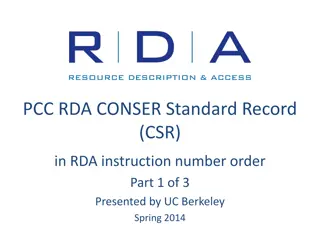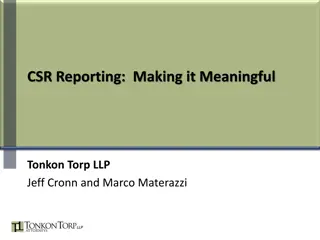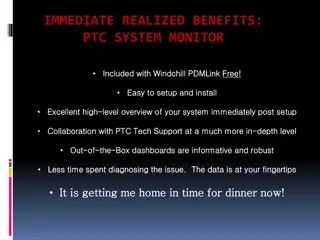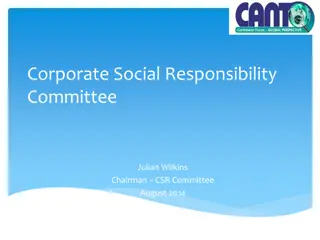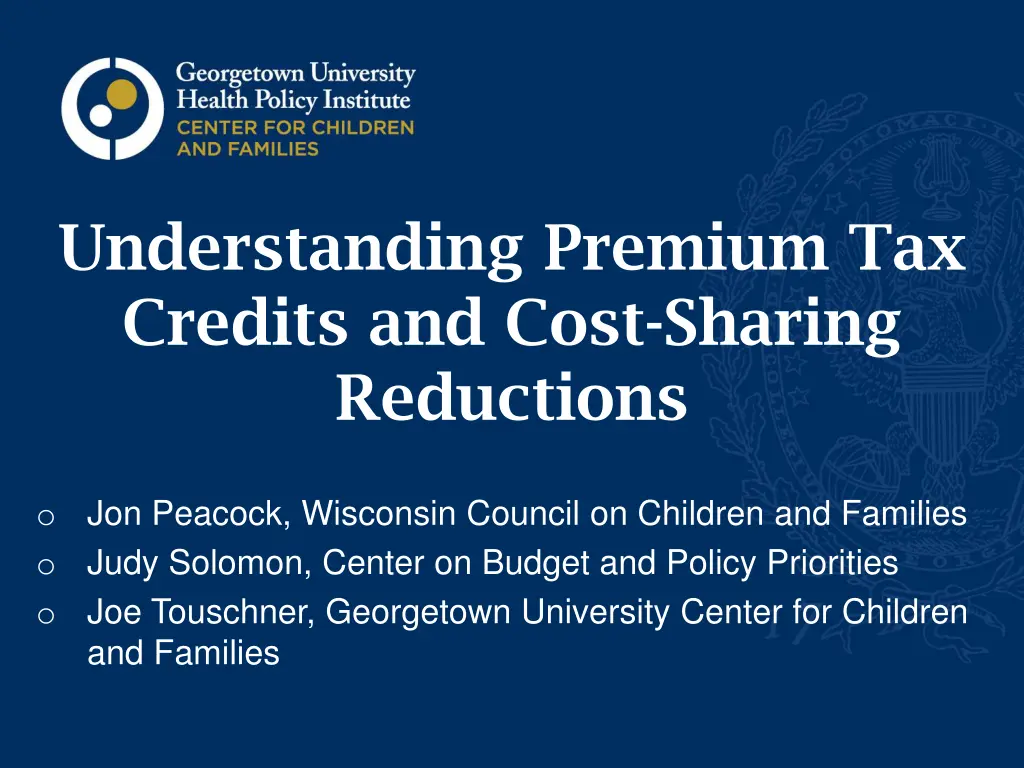
Understanding Premium Tax Credits and Cost-Sharing Reductions Explained
Learn about premium tax credits, cost-sharing reductions, eligibility criteria, coverage sources, plan tiers, and subsidies in the context of healthcare coverage landscape. Gain insights from experts on how these mechanisms impact access to affordable healthcare services.
Download Presentation

Please find below an Image/Link to download the presentation.
The content on the website is provided AS IS for your information and personal use only. It may not be sold, licensed, or shared on other websites without obtaining consent from the author. If you encounter any issues during the download, it is possible that the publisher has removed the file from their server.
You are allowed to download the files provided on this website for personal or commercial use, subject to the condition that they are used lawfully. All files are the property of their respective owners.
The content on the website is provided AS IS for your information and personal use only. It may not be sold, licensed, or shared on other websites without obtaining consent from the author.
E N D
Presentation Transcript
Understanding Premium Tax Credits and Cost-Sharing Reductions o Jon Peacock, Wisconsin Council on Children and Families o Judy Solomon, Center on Budget and Policy Priorities o Joe Touschner, Georgetown University Center for Children and Families
Agenda o Coverage overview o Premium tax credits o Eligibility o Amount o Cost-sharing o Actuarial value o Cost-sharing reductions 1
Center on Budget and Policy Priorities Coverage Landscape in 2014 FPL Unsubsidized 400% 300% Subsidized 235% 185% 200% 133% 100% 61% 37% Medicaid / CHIP 0% Children Pregnant Women Childless Adults Working Parents Jobless Parents Medicaid and CHIP coverage, based on 2012 eligibility levels in a typical state Source: Kaiser Commission on Medicaid and the Uninsured cbpp.org
Coverage sources by share of children Employer (exchange) 2.4% Nongroup (nonexchange) 0.5% Nongroup (exchange) 2.6% Source: Genevieve M. Kenney, et al., Improving Coverage For Children Under Health Reform Will Require Maintaining Current Eligibility Standards For Medicaid And CHIP, Health Affairs, December 2011. Employer (nonexchange) 47.3% Medicaid/CHIP 40.7% Other 1.3% Uninsured 5.3% 3
Center on Budget and Policy Priorities What Kind of Coverage Can People Buy? Plan Tier Actuarial Value Platinum 90% Higher premiums, lower enrollee cost-sharing Gold 80% Silver 70% Benchmark Lower premiums, higher enrollee cost-sharing Bronze 60% cbpp.org
Center on Budget and Policy Priorities Two Types of Subsidies Premium Tax Credits Help people pay the monthly cost to have a plan Cost-Sharing Reductions Decrease the charges enrollees must pay when receiving health care services covered by the plan cbpp.org
Center on Budget and Policy Priorities Premium Tax Credits cbpp.org
Center on Budget and Policy Priorities Who Is Eligible for Premium Tax Credits? Individuals and families with income between 100% to 400% FPL Must be US citizens or lawfully present in the US Must not be eligible for other minimum essential coverage Lawfully residing immigrants with incomes below 100% FPL who are not eligible for Medicaid because of their immigration status cbpp.org
Center on Budget and Policy Priorities Premium Tax Credits & Employer Coverage An individual is not eligible for premium tax credits if he is eligible for other minimum essential coverage (MEC) Most employer-sponsored coverage is MEC An offer of coverage even if it s not taken can make someone ineligible for premium tax credits Exception: Exception: an individual may be eligible for premium tax credits if the employer plan is unaffordable or inadequate and if the employee does not enroll in it 8 cbpp.org
Center on Budget and Policy Priorities Jumping the Firewall Between Employer Coverage and Premium Tax Credits If unaffordable or inadequate Offer of Offer of Employer Employer Coverage Coverage Premium Tax Credits cbpp.org
Center on Budget and Policy Priorities Jumping the Firewall: When is Employer Coverage Affordable? Coverage is considered affordable if employee contribution for self-only coverage is less than 9.5% of household income Employee contribution for self-only coverage is used to determine affordability for both employee and dependents 10 cbpp.org
Center on Budget and Policy Priorities Affordability of Family Coverage (Reyes Family) Mom works at Acme. She earns $35,000. Dad is an entrepreneur and earns about $12,000. Family Income: $47,000 Premium Cost to Employee for Employee-Only Plan: $196/mo ($2,350/yr) 5% of income Premium Cost to Employee for Family Plan: $509/mo ($6,110/yr) 13% of income 14% 12% Bottom Line: No one is eligible for premium tax credits because family coverage is considered affordable. 10% 9.5% 8% 13% 6% 4% 5% 5% 2% 0% cbpp.org Employee-Only Family
Center on Budget and Policy Priorities Jumping the Firewall: When is Coverage Adequate? Coverage is adequate if it has a minimum value (MV) of 60% This generally means that the plan pays at least 60% of spending for coverage of essential health benefits for a typical population, after accounting for cost-sharing charges required under the plan 12 cbpp.org
Center on Budget and Policy Priorities How Will an Employee Know if his Offer is Affordable or Adequate? Application has an appendix to be completed by the applicant (with help from his employer) to indicate value and cost of the plan 13 cbpp.org
Center on Budget and Policy Priorities How Is the Amount of the Tax Credit Determined? Credit amount = Cost of benchmark plan Expected premium contribution Credit amount affected by: Individual or family s expected contribution based on their income Premium cost for benchmark plan cbpp.org
Center on Budget and Policy Priorities What Is the Benchmark Plan? How Is it Determined? Second lowest cost silver plan available to each eligible household member When no one plan covers every member, may be based on one or more policies cbpp.org
Center on Budget and Policy Priorities What Is the Benchmark Plan? Effect of Pediatric Dental Benefits Benchmark is not adjusted based on whether it includes pediatric dental benefits So the benchmark and PTC amount won t rise when a family purchases a stand alone dental plan Unless the family buys a plan less expensive than the benchmark. Then there is left over credit to apply to the stand alone dental plan. cbpp.org
Center on Budget and Policy Priorities Example: Family of Four (Reyes Family) Income: $52,988 (225% FPL) Expected contribution: 7.18% or $3,802 3 Lowest Cost Silver Plans that Cover Entire Family: Plan A: $14,800 Plan B: $15,000 Plan C: $15,200 Benchmark Could be one or multiple policies Premium Credit: $15,000 - $3,802 = $11,198 cbpp.org
Center on Budget and Policy Priorities Example: Household with Ineligible Members Reyes Family: Same income In a state with CHIP up to 250% FPL Mom and dad purchase coverage, kids on CHIP 3 Lowest Cost Silver Plans Covering Mom and Dad Plan A: $9,800 Plan B: $10,000 Plan C: $10,200 Benchmark Premium Credit: $10,000 3,802 = $6,198 cbpp.org
Center on Budget and Policy Priorities Example: Household with Members Residing in Different Locations Reyes Family: Same income All members eligible Son goes to college in a different part of the state 3 Lowest Cost Silver Plans: Mom, Dad, and Daughter Son Plan A: $2,800 Plan B: $3,000 Plan C: $3,200 Plan A: $12,300 Plan B: $12,500 Plan C: $12,800 Benchmark Premium Credit: $12,500 + $3,000 3,802 = $11,698 cbpp.org
Center on Budget and Policy Priorities Comparing Three Reyes Family Scenarios Income: $52,988 (225% FPL) Expected contribution: 7.18% or $3,802 $18,000 Expected Contribution Credit Amount $16,000 Key takeaway: Applicable benchmark plan affects credit amount but not expected contribution $14,000 $12,000 $10,000 $11,698 $11,198 $8,000 $6,198 $6,000 $4,000 $3,802 $3,802 $3,802 $2,000 $0 All Members Eligible Parents Eligible, Kids in CHIP All Members Eligible, Some Residing in Different Location cbpp.org
Center on Budget and Policy Priorities How Do Rating Factors Affect the Cost of the Benchmark Plan? Age Limited to no more than 3 to 1 variation Each family member rated separately Family size Total premium for family = Sum of premiums for each family member Exception: In families with > 3 members under 21, count only 3 oldest children Geographic area cbpp.org
Center on Budget and Policy Priorities What Factors Affect What Families Will Actually Pay for Coverage? Tobacco use Difference due to tobacco use not accounted for in affordability determination OR premium credit calculation Plan chosen by consumer Amount of credit pegged to second lowest cost silver plan But consumer can purchase any metal plan Other premium obligations For example, CHIP premiums cbpp.org
Center on Budget and Policy Priorities How Do People Get Premium Credits? Submit application to the Marketplace for advance payment of credits Marketplace estimates amount of advance payment based on projected income Credit is sent directly to insurer, individual pays insurer balance of premium Can also wait until tax filing and claim on return Credits are refundable cbpp.org
Center on Budget and Policy Priorities What Happens When Estimated Income for the Year is Different from Actual Income? Final amount of credit based on actual At tax filing time, advance payments received are reconciled with actual credit amount If income increases, may have to repay If income decreases, may get more credit at tax time To avoid repayment, can reduce the amount of advance payment received during the year actual income cbpp.org
Center on Budget and Policy Priorities Cost-Sharing Standards for All Marketplace Plans Protect enrollees from very high out-of-pocket costs for covered, in-network benefits Help organize plans to make them easier for people to compare Maximum Out-of-Pocket Limit 2014 amounts: $6,350 individual/$12,700 family OOP limit is not the amount that an enrollee must spend each year cbpp.org
Center on Budget and Policy Priorities What is Actuarial Value? A way to estimate and compare the overall generosity of plans Expressed as a percentage Tells you what percentage of a typical population s costs for covered services the plan would pay for Does not represent what the plan would pay for any particular individual cbpp.org
Center on Budget and Policy Priorities What Actuarial Value Does and Does Not Do AVs under the health law focus on cost-sharing Not what benefits are covered, limits on # of visits, or what drugs are covered Not the provider network Don t tell you what any particular enrollee will pay for health care services Enrollee out-of-pocket costs depend on the medical care a person uses cbpp.org
Center on Budget and Policy Priorities Example: What Jane Pays in Different Levels of Coverage Bronze Bronze Silver Silver Gold Gold Platinum Platinum (enrollee pays) (enrollee pays) $0 $500 / admission (enrollee pays) (enrollee pays) $3,000 (enrollee pays) (enrollee pays) $2,000 $1,500 / admission (enrollee pays) (enrollee pays) $600 $1,500 / admission Deductible Inpatient (After deductible) Physician visit (After deductible) 50% 50% $30 $25 $15 Bronze $5,150 $5,150 Silver $4,190 $4,190 Gold $2,675 $2,675 Platinum $845 $845 Jane s out Jane s out- -of of- -pocket cost pocket costs s cbpp.org
Center on Budget and Policy Priorities What are Cost-Sharing Reductions? A federal benefit that reduces the out-of-pocket charges an enrollee must pay for medical care covered by the plan 3 levels of cost-sharing reductions based on income Available January 1, 2014 cbpp.org
Center on Budget and Policy Priorities Who is Eligible for Cost-Sharing Reductions? People with income up to 250% FPL Must enroll in a silver plan through the Health Insurance Marketplace (also called the exchange) cbpp.org
Center on Budget and Policy Priorities How are Cost-Sharing Reductions Provided? Enrollee cost sharing charges are automatically reduced when an eligible person or family enrolls in a silver plan People do not have to keep track of their spending or get reimbursed Not provided as a tax credit Not reconciled at the end of the year Federal government pays the health insurer upfront cbpp.org
Center on Budget and Policy Priorities Sample Cost-Sharing Reduction Plans Standard Standard Silver No CSR No CSR Silver CSR Plan for up CSR Plan for up to 150% FPL to 150% FPL (up to (up to $17,235) $17,235) CSR CSR Plan for Plan for 151 151- -200% FPL 200% FPL ($17,236 ($17,236- - $22,980) $22,980) CSR Plan for CSR Plan for 201 201- -250% 250% FPL ( ($22,981 $22,981- - $28,725) $28,725) FPL 70% AV Actuarial Value 94% AV 87% AV 73% AV Deductible (Indiv) Maximum OOP limit (Indiv) Inpatient hospital Office visit $2,000 $0 $250 $1,750 $5,500 $1,000 $2,000 $4,000 $1,500 / admission $100 / admission $250 / admission $1,500 / admission $30 $10 $15 $30 cbpp.org
Center on Budget and Policy Priorities John: John: Age: 24 24 Example 1: Silver Plan Example 1: Silver Plan Example 2: Bronze Plan Example 2: Bronze Plan Total Premium: $5,000 $5,000 Total Premium: $3,000 $3,000 Premium Credit: $3,552 $3,552 John s Premium Contribution: $121/month $121/month John s Premium Contribution: $0 / month $0 / month Income: $22,980 $22,980 Plan AV with CSR: 87% 87% Plan AV without CSR: 60% 60% Sample Silver Sample Silver- -CSR Plan (enrollee pays) (enrollee pays) CSR Plan Sample Bronze Sample Bronze Plan (enrollee pays) (enrollee pays) Plan Deductible $250 $3,000 Maximum OOP limit $6,350 $2,000 Inpatient hospital $250 / admission 50% of the charge Office visit $15 $35 cbpp.org
Center on Budget and Policy Priorities John: John: Age: 24 24 Example 1: Silver Plan Example 1: Silver Plan Example 2: Gold Plan Example 2: Gold Plan Total Premium: $5,000 $5,000 Total Premium: $6,000 $6,000 Premium Credit: $3,552 $3,552 John s Premium Contribution: $121/month $121/month John s Premium Contribution: $204/month $204/month Income: $22,980 $22,980 Plan AV with CSR: 87% 87% Plan AV without CSR: 80% 80% Sample Silver Sample Silver- -CSR Plan (enrollee pays) (enrollee pays) CSR Plan Gold Plan Gold Plan (enrollee pays) (enrollee pays) Deductible $250 $600 Maximum OOP limit $4,000 $2,000 $1,000 / admission Inpatient hospital $250 / admission $25 Office visit $15 cbpp.org
Center on Budget and Policy Priorities Key Considerations in Plan Selection What health care expenses are likely Upfront cost-sharing (the deductible), as-you- go cost-sharing (like copayments) Other aspects of the plan, such as provider network and covered drugs What benefits are covered under various plans (may vary depending on state) cbpp.org
Questions? o Judy Solomon o solomon@cbpp.org o Joe Touschner o jdt38@georgetown.edu o Jon Peacock o jpeacock@wccf.org










